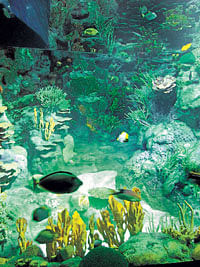
When a theme-park with over 50 lakh annual visitors decides to reduce its carbon footprint and promote conservation with systematic and wide-ranging measures, you can be sure it will make a significant positive difference to the environment. So, even as Ocean Park at Hong Kong, one of the world’s most-visited theme-parks, provides a world-famous tourist attraction, with fascinating oceanarium, dazzling shows and facilities for fun and education, it also offers an inspiring example of conservation efforts. It is ranked 14th in the world, fifth in Asia and first in China for annual attendance among theme-parks.
As Tom Mehrmann, Chief Executive, Ocean Park, Hong Kong says, “One of our primary missions is to help in the understanding and practice of wildlife conservation. In fact, we have three core objectives at Ocean Park, conservation, education and entertainment.”
The park has set up a dedicated facility for this first objective, the Ocean Park Conservation Foundation (OPCF) which coordinates international efforts to conserve endangered marine mammals in Asia and improve conservation practices across Asia, explains Suzanne M Gendron, Director of OPCF and also Ocean Park’s Executive Director of Zoological Operations and Education.
Treasure house of rare species
The park showcases many of the species it is actively working to conserve. There is the Giant Panda Adventure, where you will constantly hear delighted squeals of excited kids and adults too, an interesting habitat for rare species like the giant panda, red panda, Asian small-clawed otter, Chinese alligator, and Chinese giant salamander. Goldfish Treasures has a collection of over 300 goldfish including the world’s largest variety.
Another fascinating enclosure is the Sea Jelly Spectacular which is Asia’s first stand-alone sea-jelly exhibit with over 1,000 specimens visible. Grand Aquarium features the world’s largest aquarium viewing dome (5.5 metres in diameter with 13-metre-wide acrylic viewing panel) for stunning views of aquatic creatures living inside the world’s ninth largest aquarium by tank volume. It is designed to simulate a spiralling deep-sea diving experience among the multisensory experiences it offers!
Ocean Park boasts the world’s first successful birth of two bottlenose dolphin calves from artificial insemination. In fact, the park uses its unique collection of insects, birds, fish and marine animals for successful breeding programmes. So, it has also recorded the birth of rare shark species, sea-lions, sea-horses and several species of sea-jellies while endangered birds are also being hatched and reared here.
Eco-friendly measures
One dollar from every ticket goes to OPCF to support its wildlife-conservation efforts in Asia, reveals Suzanne. There are petrol/electric powered cars for use by staff and visitors. Use of plastic bags in stores has been reduced. At kiosks/restaurants, straws are given out only when asked for. Fresh-water usage is massively reduced since only salt water is used for flushing in the toilets, she adds.
There are signs which ask you to segregate waste and place the recyclable plastic items into designated waste-bins. Compost bins, eco-friendly oils and gases, use of biodegradable and recyclable materials, and recycling of cardboard boxes are other ecofriendly measures. All these efforts have paid off. “Thus, as a park we have 12 per cent less carbon emissions than other international theme parks,” says Suzanne. That is truly gratifying for the management. This park which aims to reproduce a complete ocean-ecosystem feel has a major thrust on education especially for children, after all, they are the inheritors of tomorrow’s world. A Clean Air Outreach Programme of Ocean Park Academy (OPA) spreads the message of environment conservation through a mobile exhibition which visits over 30 schools and 3,000 students every year. Additionally, the OPA runs educational tours for schoolchildren and workshops for teachers. Each year, the park offers over 30 core courses for around 40,000 students on topics like dolphins, sea-lions, pandas, fish, birds, etc. There are designated Ocean and Coral Classrooms. Nearly six lakh students have participated in Ocean Park’s educational programmes so far. The whimsical sculptures in different synthetic materials and the bushes crafted to resemble marine life not contribute to the thematic design of Ocean Park but also reinforce the marine-conservation message.
Bringing ocean into ocean parks...
At the newly opened Aqua City, “a theme zone which attempts to bring more ocean into the ocean park,” as Tod quips, there are similar ecofriendly measures being worked out. Aqua City showcases the world’s first and only 360 degree water-screen for its night-time show Symbio, an amazing spectacle of visual, water, fire and special effects to specially composed music by Oscar-winner Peter Lehman. Featuring many of the park’s iconic animal species, the show conveys a strong message about the need to protect the world’s precious natural resources and a sustainable ocean ecosystem. Aqua City is all about education through entertainment, says Tod.
Ocean Park does its best to be socially responsible. However, they are candid enough to admit that much more can be done if relevant technology is made accessible. Sometimes, the wherewithal is not easily available and/or is prohibitively expensive.
As Suzanne reveals: “For example, we would love to have our night lighting powered by solar energy but right now we do not have the wherewithal. We are eagerly awaiting the time when more eco-friendly technologies like these come into easy reach so we can further reinforce our eco-friendly orientation.”
Ocean Park keeps a lookout for new measures to reduce the carbon footprint.
In every project undertaken, the management requests the engineers, architects, interior decorators, everyone involved, to ensure minimal damage to the environment and maximise eco-friendliness. An environmental-safety section regularly educates staff on how to reduce, re-use and recycle.